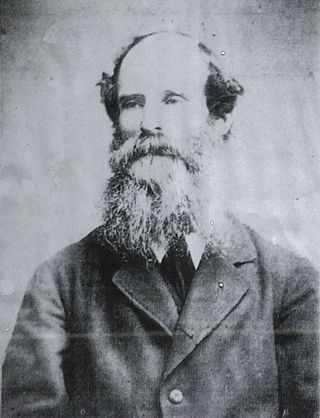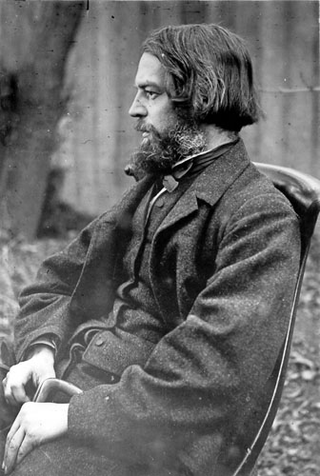Related Research Articles

Sir George Gilbert Scott, largely known as Sir Gilbert Scott, was a prolific English Gothic Revival architect, chiefly associated with the design, building and renovation of churches and cathedrals, although he started his career as a leading designer of workhouses. Over 800 buildings were designed or altered by him.

Sir Arthur William Blomfield was an English architect. He became president of the Architectural Association in 1861; a Fellow of the Royal Institute of British Architects in 1867 and vice-president of the RIBA in 1886. He was educated at Trinity College, Cambridge, where he studied Architecture.

William White, FSA (1825–1900) was an English architect, noted for his part in 19th-century Gothic Revival architecture and church restorations.

Bow Church is the parish church of St Mary and Holy Trinity, Stratford, Bow. It is located on a central reservation site in Bow Road, in Bow, in the London Borough of Tower Hamlets. There has been a church on the same site for approximately 700 years. The church was bombed in the Second World War, and the bell tower was reconstructed just after the war.

Benjamin Woolfield Mountfort was an English emigrant to New Zealand, where he became one of the country's most prominent 19th-century architects. He was instrumental in shaping the city of Christchurch's unique architectural identity and culture, and was appointed the first official Provincial Architect of the developing province of Canterbury. Heavily influenced by the Anglo-Catholic philosophy behind early Victorian architecture, he is credited with importing the Gothic revival style to New Zealand. His Gothic designs constructed in both wood and stone in the province are considered unique to New Zealand. Today, he is considered the founding architect of the province of Canterbury.

Ramsgate is a seaside town in the district of Thanet in east Kent, England, with a population of 39,639 in the '2001 UK Census. It was one of the great English seaside towns of the 19th century. Ramsgate's main attraction is its coastline, and its main industries are tourism and fishing. The town has one of the largest marinas on the English south coast, and the Port of Ramsgate provided cross-channel ferries for many years.
Benjamin Ferrey FSA FRIBA was an English architect who worked mostly in the Gothic Revival.

John Dando Sedding was an English church architect, working on new buildings and repair work, with an interest in a "crafted Gothic" style. He was an influential figure in the Arts and Crafts movement, many of whose leading designers, including Ernest Gimson, Ernest Barnsley and Herbert Ibberson, studied in his offices.

St Dionis Backchurch was a parish church in the Langbourn ward of the City of London. Of medieval origin, it was rebuilt after the Great Fire of London to the designs of Christopher Wren and demolished in 1878.
Henry Isaac Stevens FRIBA was an architect based in Derby. He was born in London, in 1806, and died in 1873. In the late 1850s he changed his name to Isaac Henry Stevens.

Holy Trinity, Minories, was a Church of England parish church outside the eastern boundaries of the City of London, but within the Liberties of the Tower of London and therefore in the East End of London. The liberty was incorporated in the Metropolitan Borough of Stepney in 1899, and today is within the City of London. Converted from the chapel of a nunnery, Holy Trinity was in use as a church from the 16th century until the end of the 19th century. It survived as a parish hall until it was destroyed by bombing during World War II.
John Whichcord Sr. (1790–1860) was a British architect who worked in Maidstone, Kent and designed many public and institutional buildings in the town.
Joseph Clarke (1819–1888) was a British Gothic Revival architect who practised in London, England.
Cox & Barnard Ltd was a stained glass designer and manufacturer based in Hove, part of the English city of Brighton and Hove. The company was founded in Hove in 1919 and specialised in stained glass for churches and decorative glass products. Many commissions came from Anglican and Roman Catholic churches in the English counties of East Sussex, West Sussex and Kent. The company was also responsible for six war memorial windows at an Anglican church in Canada, made from shards of glass collected from war-damaged church windows across Europe.

All Saints' Church, also known as Lydd Church or The Cathedral on the Marsh, is a church in Lydd, Kent, South East England. It belongs to the Diocese of Canterbury. All Saints is the longest parish church in Kent at 199 feet (61 m), and also has one of the tallest towers in the county at 132 feet (40 m). The church is thought to incorporate a small Romano-British basilica possibly built in the 5th century, though most of the current fabric is medieval. It was associated with local fraternities or guilds in the 15th century and could seat 1,000 people at a time. Severely damaged by World War II bombing, the church was subsequently restored and is now a Grade I listed building.

Holy Trinity Church is a Church of England parish church in Rotherhithe, south east London, within the diocese of Southwark.
William Edmunds was a British architect who designed Margate Lighthouse, Holy Trinity Church, Margate and Holy Trinity Church, Dover. He was also father of the convicted murderer Christiana Edmunds.
Holy Trinity Church, Dover was a church designed by William Edmunds. Building of the church began in September 1833 and it was completed in 1835. It was demolished after being damaged by German air raids and cross-channel shelling during World War II.

Holy Trinity Church, Dartford, is a parish church affiliated with the Church of England in Dartford, Kent. It is a Grade I listed building dating from the 11th century.
References
- 1 2 3 4 5 6 7 Lee, Anthony. "The sad tale of the Margate architect and the Brighton poisoner" (PDF). Margate in Maps and Pictures. Retrieved 16 April 2020.
- 1 2 3 Walton, Hugh Merscy. "A short history of Holy Trinity Church Margate 1825-1932" (PDF). Retrieved 17 April 2020.
- 1 2 3 Tritton, Paul (7 May 2014). "Death and destruction 70 years ago in Kent's 'bomb alley'" (PDF). Kent Archaeological Society. Retrieved 17 April 2020.